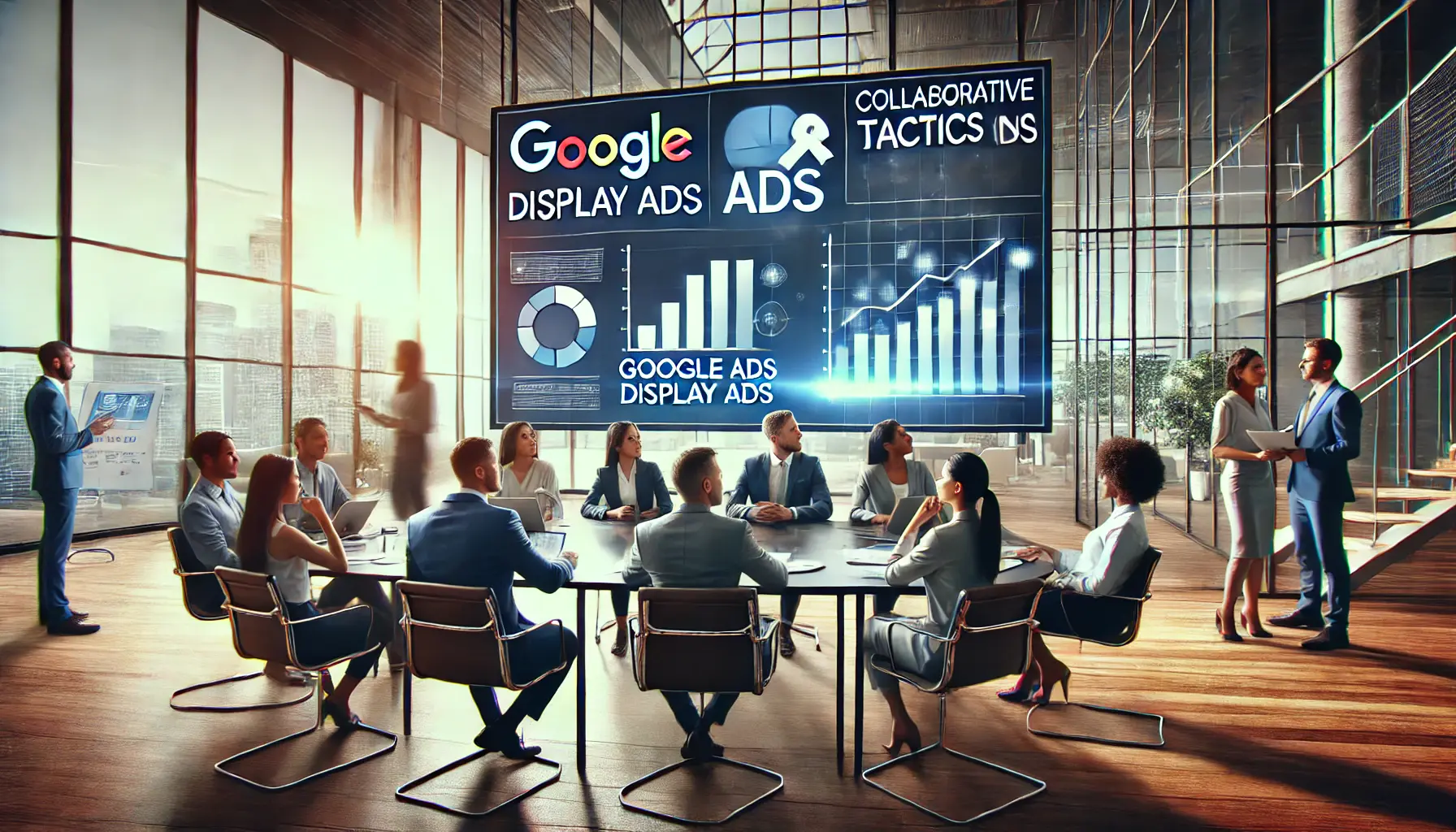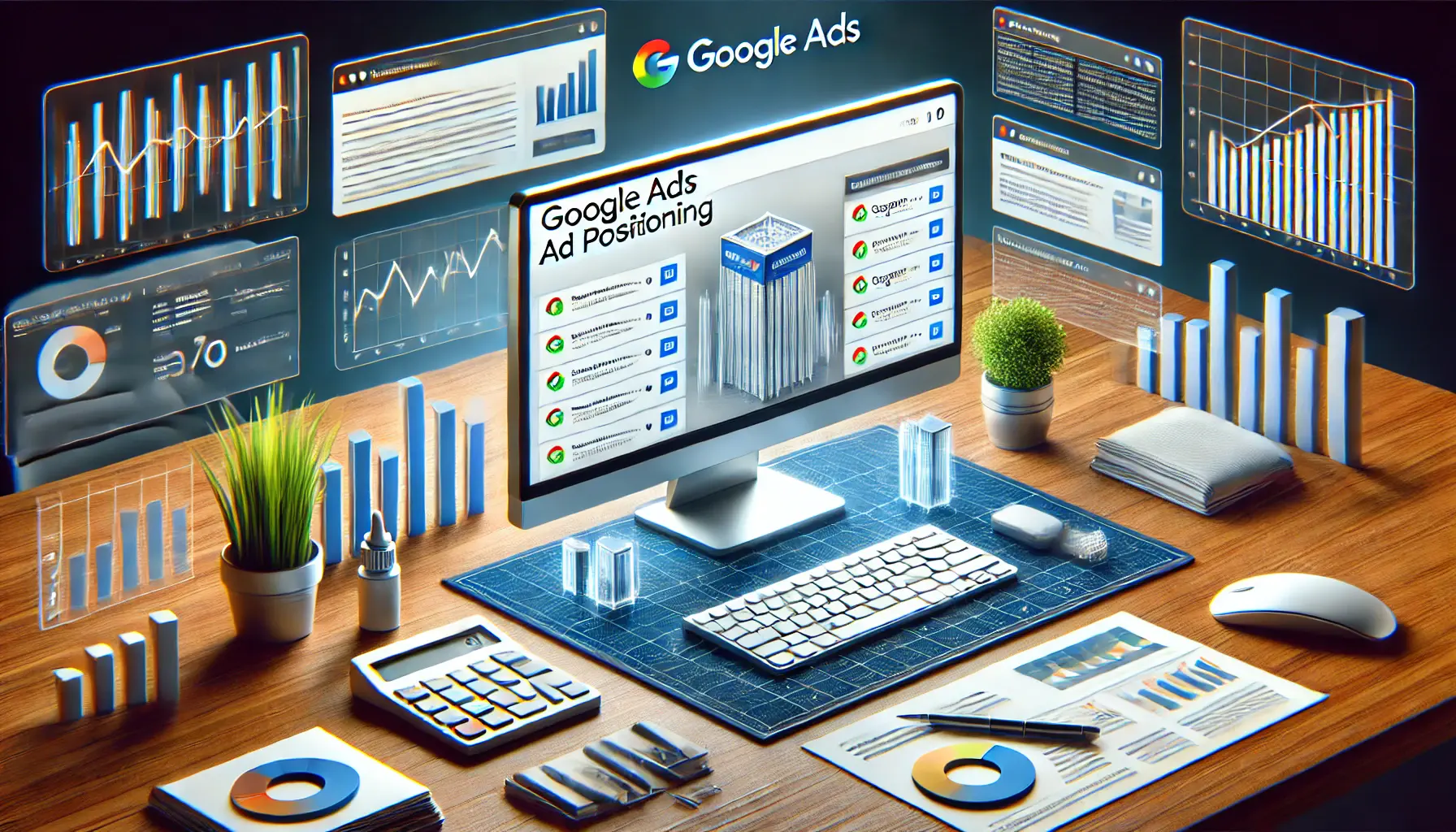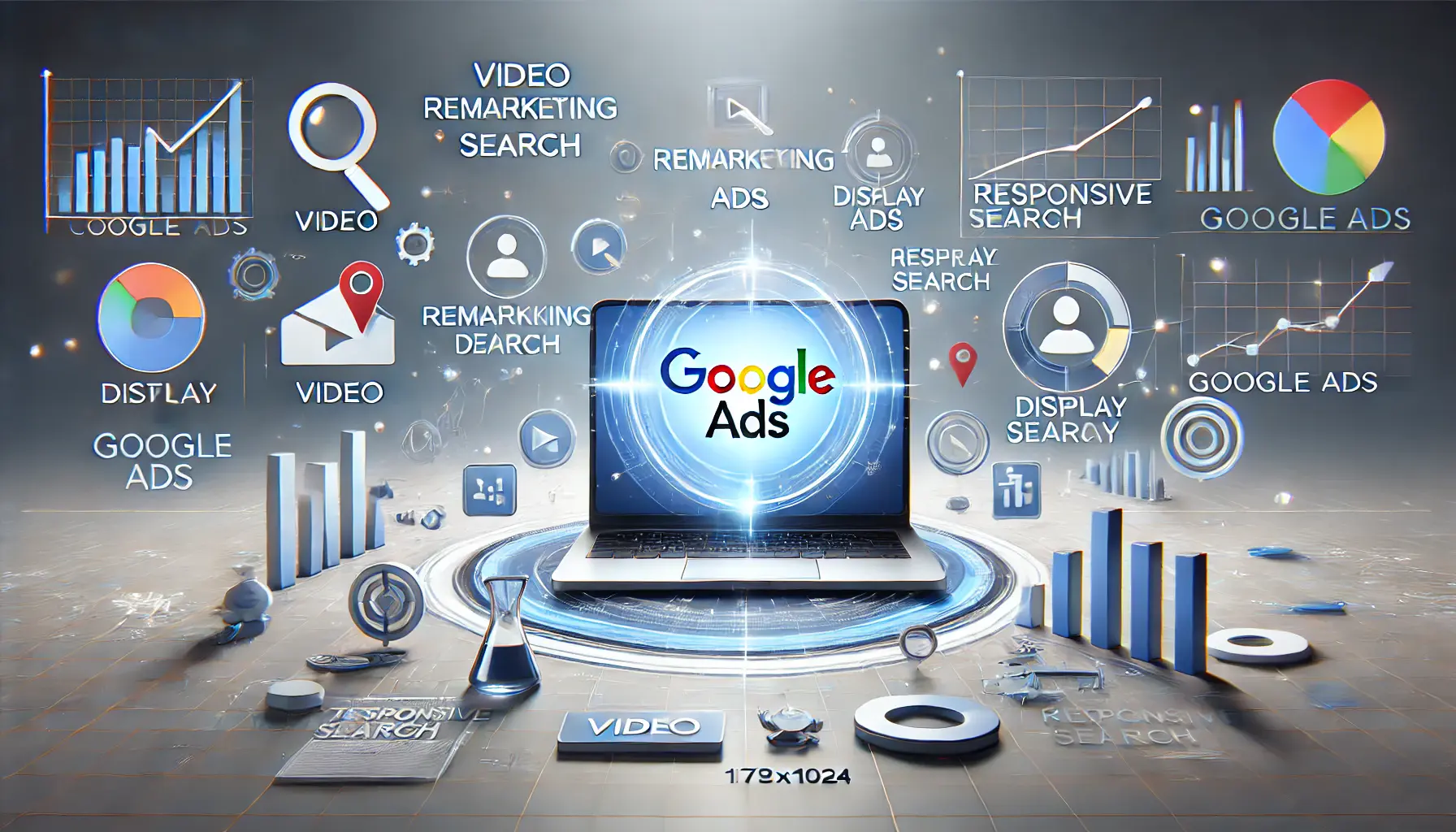In the competitive digital marketing landscape, standing out in Google Display Ads requires more than mere creativity; it demands collaboration.
By pooling resources, expertise, and innovative strategies, businesses can amplify their advertising impact through collaborative tactics.
These strategies not only enhance visibility but also allow brands to tap into shared audiences and achieve mutually beneficial outcomes.
In this article, we’ll explore the most effective collaborative tactics in Google Display Ads, starting with a deep dive into understanding what they are and how they can transform your advertising efforts.
- Understanding Collaborative Tactics in Google Display Ads
- Audience Segmentation for Collaborative Campaigns
- Co-Branding Strategies to Maximize Engagement
- Optimize Ad Spend by Focusing on Strategic Partnerships
- Measuring the Success of Collaborative Tactics in Google Display Ads
- Key Takeaways on Collaborative Tactics in Google Display Ads
- Google Display Ads: Collaborative Tactics – Frequently Asked Questions
Understanding Collaborative Tactics in Google Display Ads
Collaborative tactics in Google Display Ads involve partnering with other brands, creators, or platforms to maximize the reach and effectiveness of your campaigns.
By pooling resources and aligning goals, these partnerships create synergiesInteractions or cooperation between two or more entities to produce a combined effect greater than the sum of their separate effects. that are often impossible to achieve individually.

Visual representation of collaborative tactics in digital marketing.
What are Collaborative Tactics?
Collaborative tactics are strategies where two or more entities come together to create and execute advertising campaigns.
These campaigns leverage the unique strengths of each partner, such as audience reach, expertise, or brand credibility, to create a win-win situation.
- Shared Goals: The key to successful collaboration is setting common objectives, whether it’s increasing brand awareness or driving more conversions.
- Resource Sharing: Collaborations often involve sharing budgets, creative assets, or data to optimize campaign performance.
- Mutual Benefits: The essence of collaboration is creating value for all involved parties, ensuring everyone achieves measurable results.

Collaborative teamwork driving innovation in digital advertising.
The Role of Collaboration in Digital Advertising
In today’s competitive advertising space, collaboration offers a unique edge.
By working with complementary brands or creators, you can:
- Expand Audience Reach: Tap into new markets by leveraging your partner’s audience base.
- Enhance Creativity: Combine ideas and perspectives to create more engaging ads.
- Improve Credibility: Associating with trusted partners can elevate your brand’s reputation.
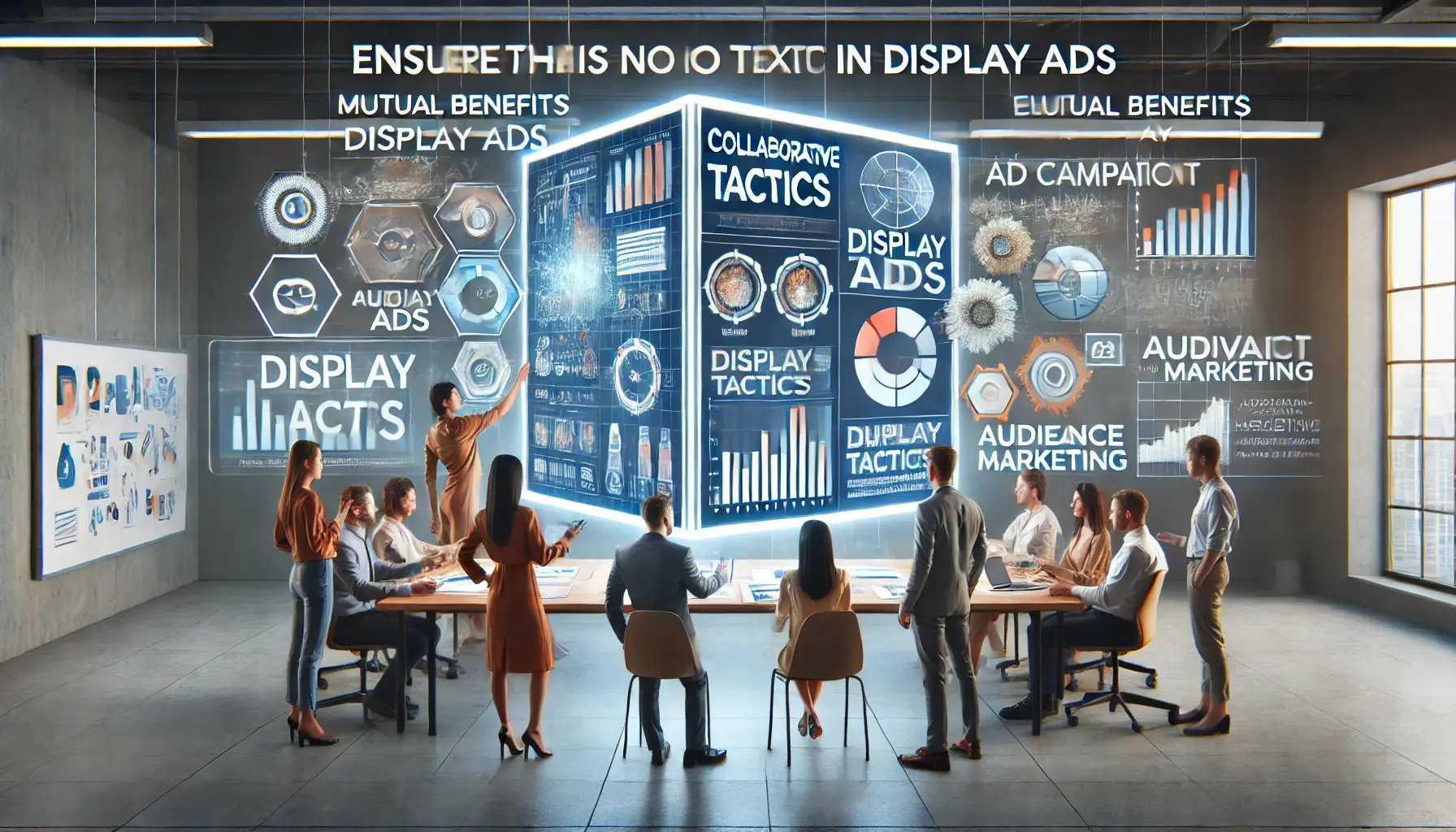
The power of collaboration: Unlocking new possibilities in display ads.
Why Use Collaborative Tactics in Display Ads?
Collaborative tactics offer numerous benefits for businesses of all sizes.
Some of the most significant advantages include:
- Cost Efficiency: Sharing resources helps reduce the overall cost of campaigns.
- Higher Engagement Rates: Collaborations often result in more personalized and relevant ads, driving better engagement.
- Shared Expertise: Partners bring unique insights and skills that can improve campaign outcomes.

Real-world success: Brands collaborating to create impactful co-branded campaigns.
Real-World Examples of Collaboration in Ads
To understand the power of collaborative tactics, let’s consider some real-world examples:
- Co-Branded Campaigns: Famous examples include tech companies partnering with fashion brands to showcase innovative gadgets in stylish settings.
- Influencer Collaborations: Businesses often team up with influencers to promote products, leveraging their authenticity and follower base.
- Cross-Promotions: Partnering with complementary brands to offer bundled deals or shared campaigns can drive impressive results.
Collaborative tactics are a game-changer in Google Display Ads, enabling you to break through the noise and connect with your audience in impactful ways.
Now that you know what these strategies are, let’s move on to the next section to understand how to effectively segment your audience for collaborative campaigns.
Collaborative tactics in Google Display Ads allow businesses to create impactful campaigns by pooling resources and aligning goals, leading to synergies that are hard to achieve individually.

Strategic insights: Audience segmentation drives collaboration success.
Audience Segmentation for Collaborative Campaigns
Effectively segmenting your audience is crucial for the success of collaborative campaigns in Google Display Ads.
By identifying and targeting specific audience segments, you can tailor your messaging to resonate more deeply, ensuring that your collaborative efforts reach the right people at the right time.

Finding common ground: Exploring shared audience interests for impactful campaigns.
Identifying Shared Audience Interests
When collaborating with partners, it’s essential to identify overlapping audience interests.
This alignment allows for the creation of ads that appeal to both brands’ customer bases, enhancing engagement and conversion rates.
- Analyze Customer Data: Examine your existing customer data to identify common interests and behaviors.
- Use Market Research Tools: Utilize tools like Google Ads’ Audience Manager to gain insights into audience demographics and interests.
- Conduct Surveys: Engage with your audience directly through surveys to understand their preferences and interests.

Strategic collaboration through demographic insights.
Leveraging Demographics for Collaboration
Demographic targeting allows you to reach specific groups based on characteristics such as age, gender, income, and education level.
By aligning these demographicsStatistical data relating to the population and specific groups within it, such as age, gender, or income. with your partner’s audience, you can create more personalized and effective ad campaigns.
- Define Target Demographics: Clearly outline the demographic profile of your ideal customer.
- Align with Partner Demographics: Ensure that your partner’s audience demographics complement or overlap with yours.
- Customize Ad Content: Develop ad creatives that speak directly to the shared demographic characteristics.
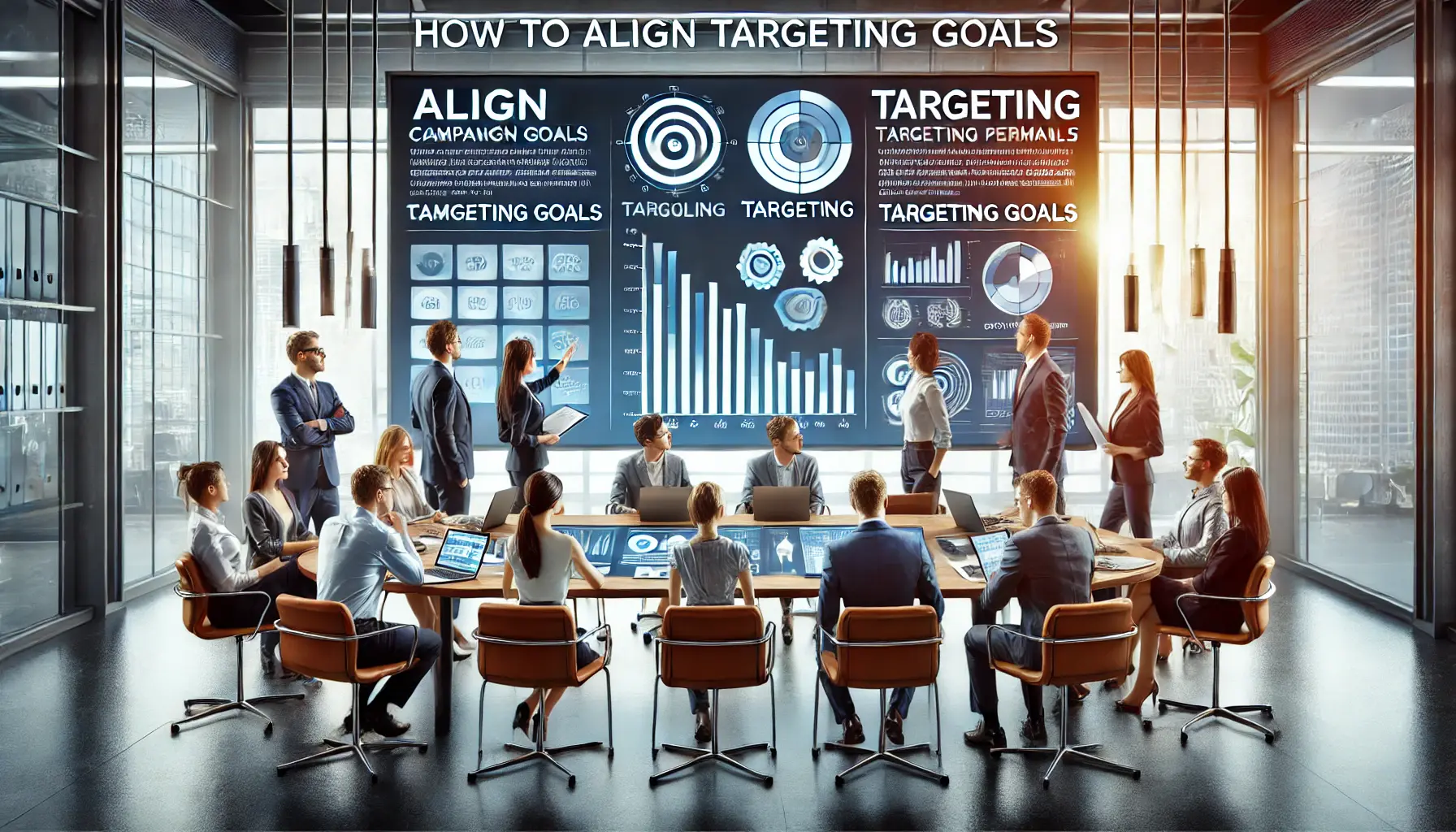
Achieving harmony: Aligning targeting goals with partners for campaign success.
How to Align Targeting Goals with Partners
Successful collaboration requires aligning your targeting goals with your partner’s objectives.
This alignment ensures that both parties benefit from the campaign and that the messaging remains consistent and effective.
- Set Clear Objectives: Define what you aim to achieve through the collaboration, such as increased brand awareness or higher conversion rates.
- Communicate Openly: Maintain open communication with your partner to ensure alignment on goals and strategies.
- Develop Joint Strategies: Work together to create ad campaigns that reflect both brands’ values and objectives.

Empowering strategies: Tools driving effective audience segmentation.
Tools for Effective Audience Segmentation
Several tools can assist in effective audience segmentation, enabling you to target your collaborative campaigns more precisely.
- Google Ads Audience Manager: Allows you to create and manage audience segments based on various criteria.
- Google Ads Custom Segments: Enables the creation of custom audience segments tailored to your specific needs.
- Analytics Platforms: Utilize analytics tools to gain deeper insights into audience behavior and preferences.
By effectively segmenting your audience and aligning your targeting goals with your partners, you can enhance the success of your collaborative campaigns in Google Display Ads.
Next, we shall look at the co-branding strategies to maximize engagement.
Segmenting audiences based on shared interests, demographics, and behaviors ensures that collaborative campaigns resonate deeply with targeted groups.

Unified creativity: Co-branding strategies for enhanced audience engagement.
Co-Branding Strategies to Maximize Engagement
Co-branding in Google Display Ads involves two or more brands collaborating to create a unified advertising campaign.
This strategy leverages the strengths and audiences of each brand, resulting in increased engagement and broader reach.
By combining resources and creativity, co-branding can lead to more compelling ads that resonate with a wider audience.
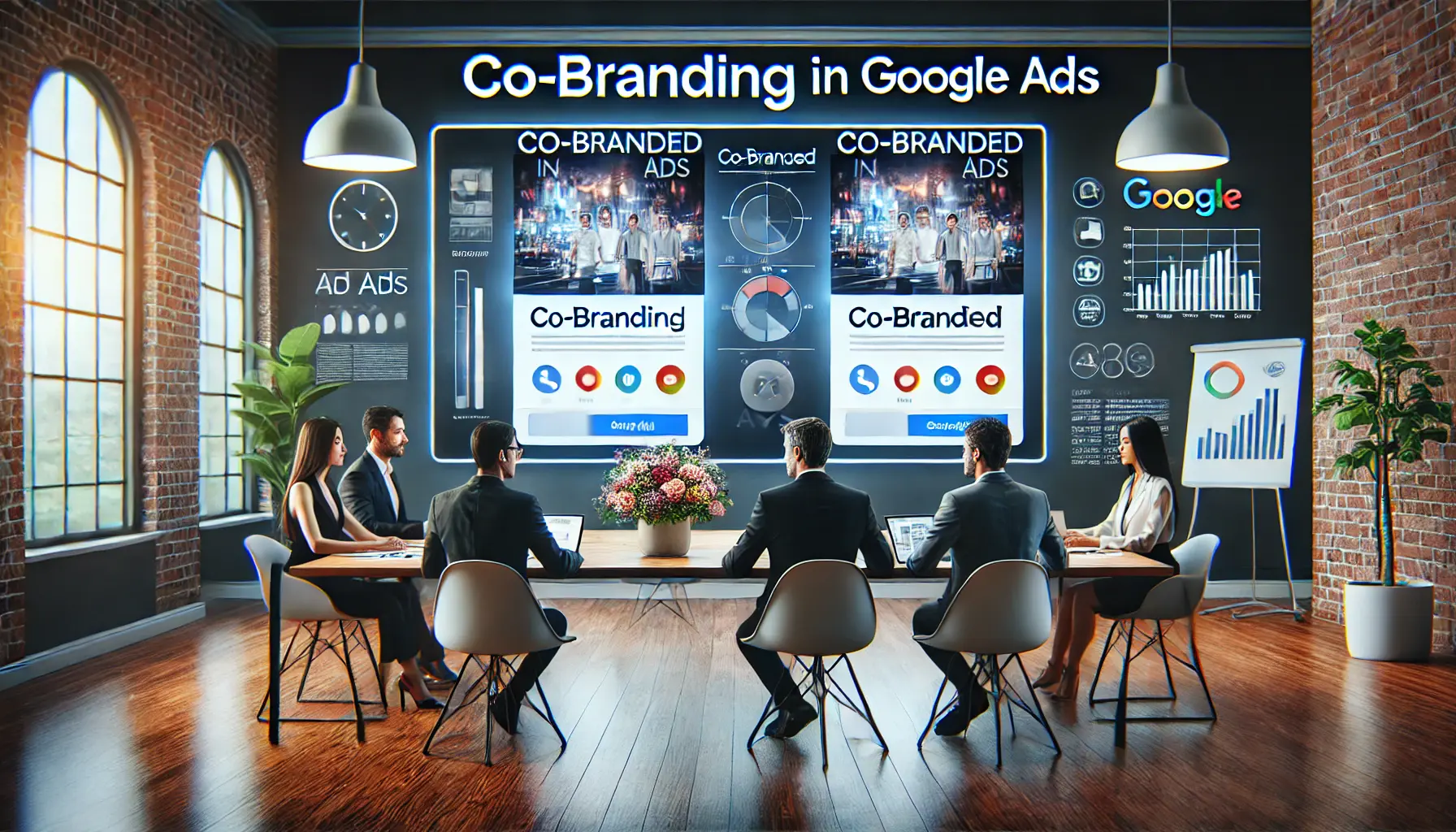
Collaborative success: Understanding co-branding in Google Ads.
What is Co-Branding in Google Ads?
Co-branding in Google Ads refers to a partnership where multiple brands jointly create and promote advertisements.
This collaboration aims to:
- Leverage Combined Brand Equity: Utilize the established reputation and trust of each brand to enhance the ad’s credibility.
- Expand Audience Reach: Access and engage with the partner brand’s customer base, introducing your brand to new potential customers.
- Share Resources and Expertise: Combine creative assets, marketing budgets, and industry knowledge to produce more effective campaigns.
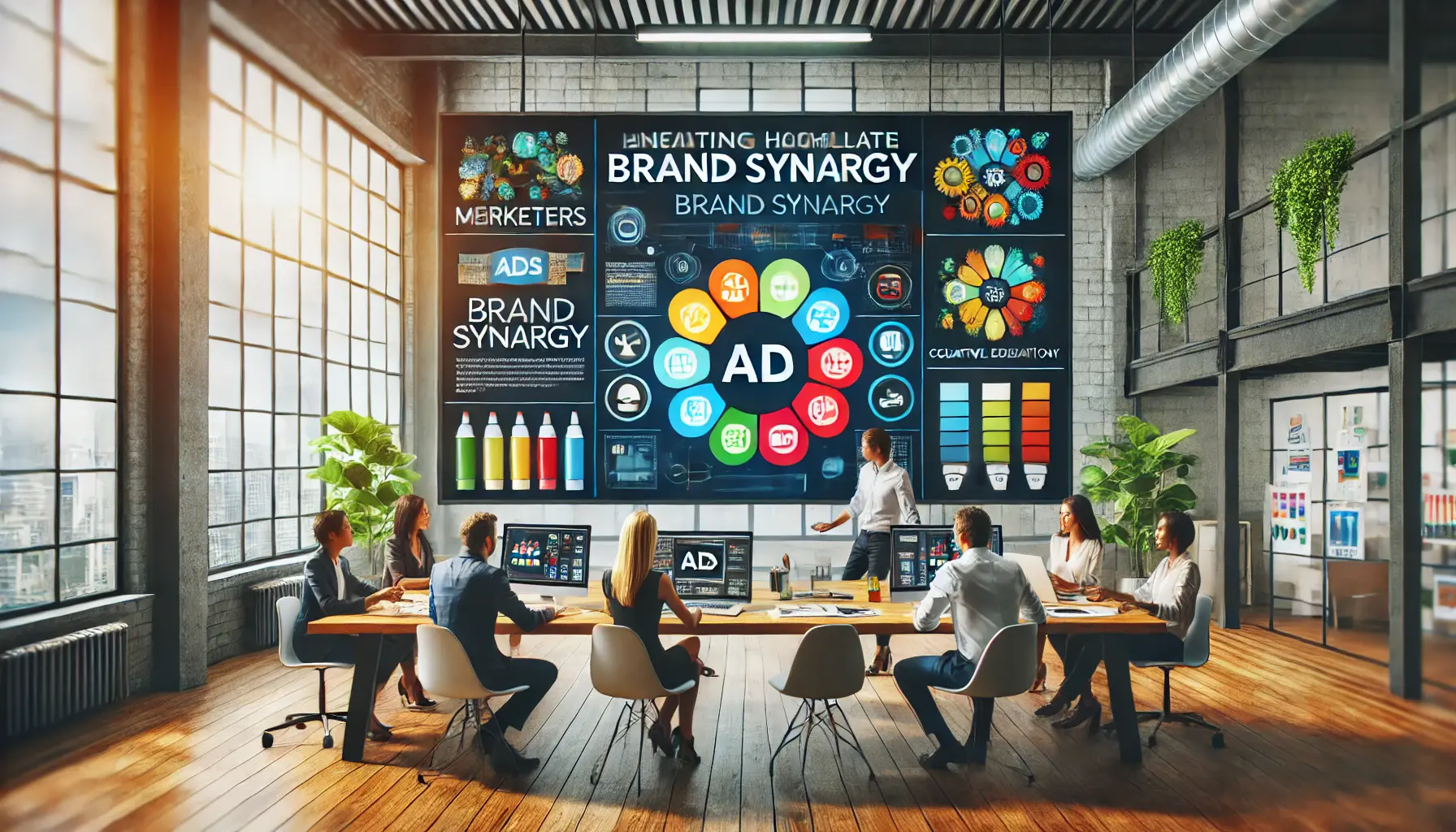
Unified creativity: Designing ads that highlight brand synergy.
Creating Ads That Highlight Brand Synergy
To effectively showcase brand synergy in co-brandedA marketing partnership between two brands to create a single product or campaign. ads:
- Develop a Unified Message: Craft a central theme that reflects the values and goals of all participating brands.
- Incorporate Visual Elements from Each Brand: Use logos, color schemes, and design elements that represent each brand, ensuring a cohesive look.
- Emphasize Complementary Strengths: Highlight how the collaboration offers unique value to the audience, such as combining expertise or product features.

Seamless branding: Ensuring visual consistency across campaigns.
Visual Consistency Across Collaborative Campaigns
Maintaining visual consistency is crucial for the success of co-branded campaigns:
- Establish Brand Guidelines: Agree on design standards, including fonts, colors, and imagery, to ensure a harmonious appearance.
- Use Responsive Display Ads: Implement responsive ads that adapt to various devices and platforms while maintaining consistent branding.
- Coordinate Across All Marketing Channels: Ensure that the co-branded visuals are consistent across social media, websites, and other advertising mediums.

Data-driven insights: Tracking the success of co-branding campaigns.
Measuring the Success of Co-Branding Efforts
To evaluate the effectiveness of co-branding campaigns:
- Define Key Performance Indicators (KPIs): Establish metrics such as click-through rates, conversion rates, and engagement levels to assess performance.
- Analyze Brand Lift: Measure increases in brand awareness and perception resulting from the co-branded campaign.
- Gather Audience Feedback: Collect insights from customers to understand their response to the collaboration and identify areas for improvement.
By implementing these co-branding strategies in your Google Display Ads, you can enhance engagement, reach new audiences, and create memorable advertising experiences.
In the next section, we’ll explore how to optimize ad spend through strategic partnerships.
Co-branding strategies enhance engagement by leveraging combined brand equity, audience reach, and shared expertise.
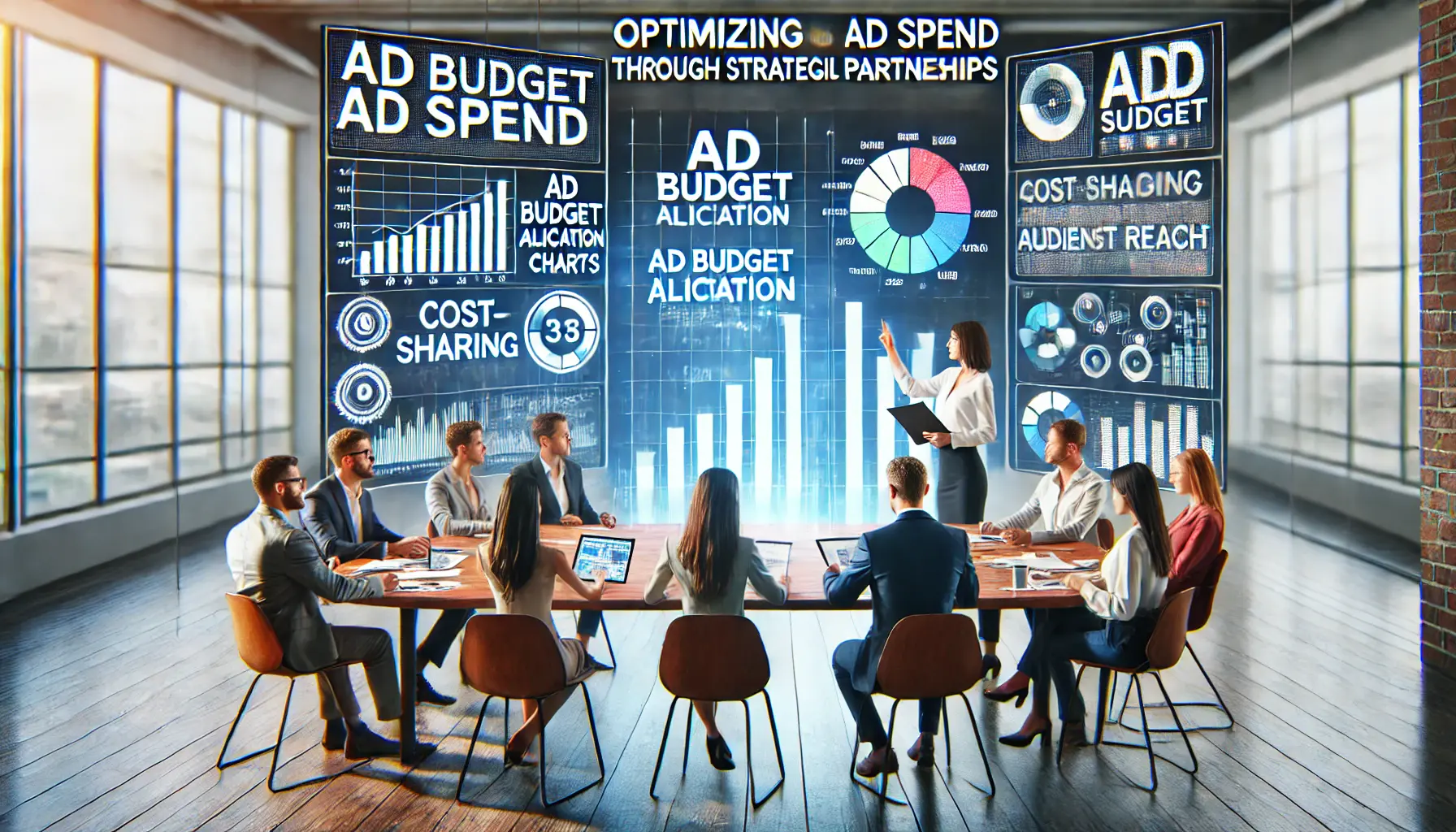
Strategic collaboration: Optimizing ad spend through partnerships.
Optimize Ad Spend by Focusing on Strategic Partnerships
Collaboration tactics for Google Display Ads can greatly enhance your advertising efficiency.
By forming strategic partnerships, you can optimize your ad spend, reach a broader audience, and achieve better results without increasing your budget.
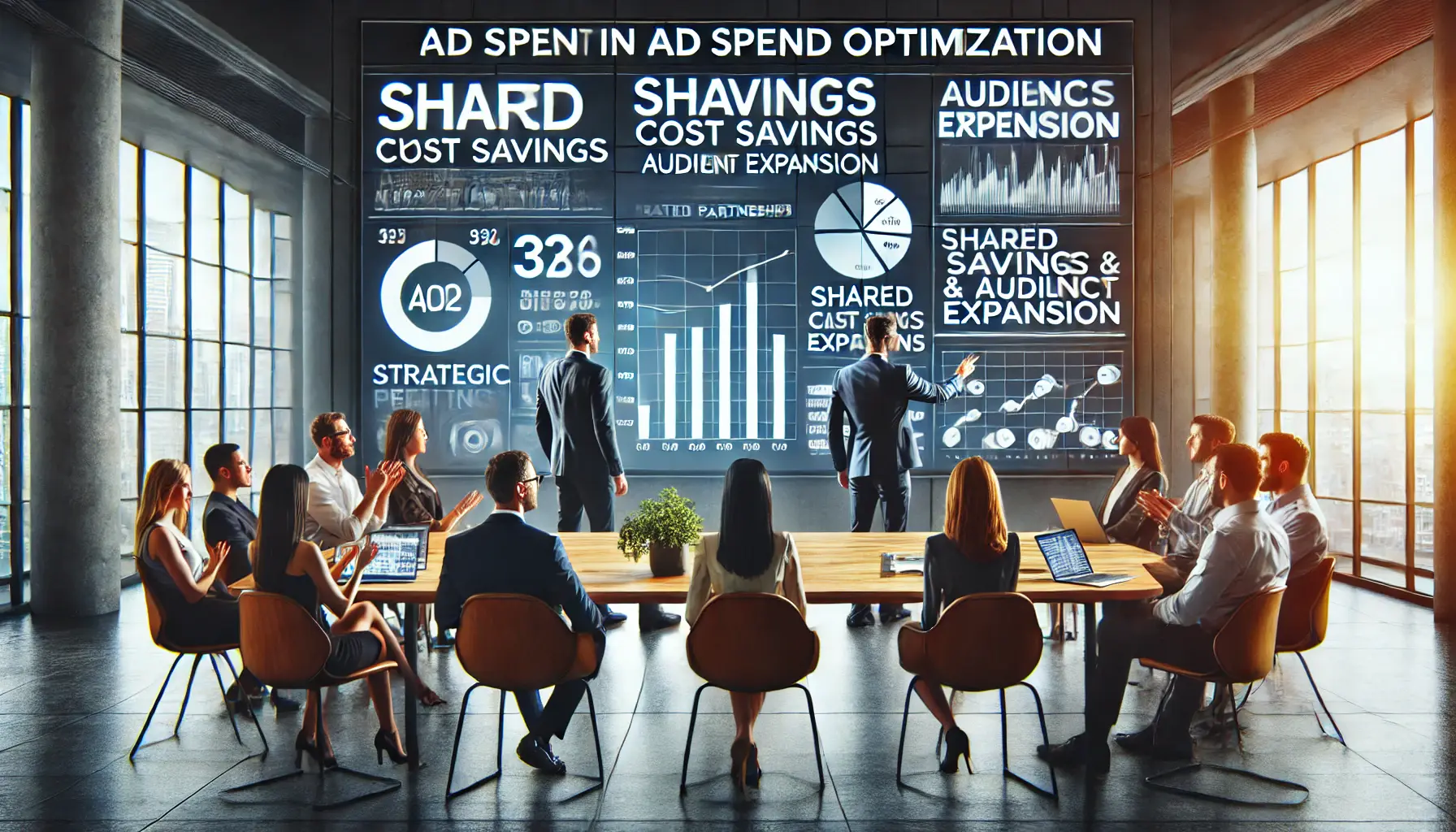
Maximizing efficiency: Exploring the benefits of strategic partnerships.
Benefits of Strategic Partnerships in Ad Spend Optimization
Engaging in strategic partnerships offers several advantages:
- Shared Costs: Splitting advertising expenses with partners reduces individual financial burdens.
- Access to New Audiences: Partners can introduce your brand to their customer base, expanding your reach.
- Enhanced Credibility: Associating with reputable partners can boost your brand’s trustworthiness.

Unified efforts: Collaborating on joint marketing campaigns.
Implementing Joint Marketing Campaigns
To effectively execute joint marketing campaigns:
- Align Objectives: Ensure both parties have shared goals for the campaign.
- Develop Integrated Strategies: Create cohesive ad content that reflects both brands’ identities.
- Utilize Combined Resources: Leverage each partner’s strengths, such as creative assets or data insights.

Maximizing efficiency: Co-branding for strategic budget use.
Utilizing Co-Branding to Maximize Budget Efficiency
Co-branding can lead to more efficient use of your advertising budget:
- Leverage Combined Brand Equity: Utilize the established reputation and trust of each brand to enhance the ad’s credibility.
- Expand Audience Reach: Access and engage with the partner brand’s customer base, introducing your brand to new potential customers.
- Share Resources and Expertise: Combine creative assets, marketing budgets, and industry knowledge to produce more effective campaigns.

Data-driven insights: Measuring ROI in collaborative advertising.
Measuring the ROI of Collaborative Advertising Efforts
To assess the return on investment (ROI) of your collaborative campaigns:
- Define Key Performance Indicators (KPIs): Establish metrics such as click-through rates, conversion rates, and engagement levels to assess performance.
- Analyze Brand Lift: Measure increases in brand awareness and perception resulting from the co-branded campaign.
- Gather Audience Feedback: Collect insights from customers to understand their response to the collaboration and identify areas for improvement.
By leveraging strategic partnerships in your Google Display Ads, you can optimize your ad spend, enhance campaign performance, and achieve your marketing objectives more effectively.
Next, we will discuss how to measure the success of collaborative tactics in your advertising efforts.
Strategic partnerships optimize ad spend by sharing costs, accessing new audiences, and leveraging combined resources for greater efficiency.
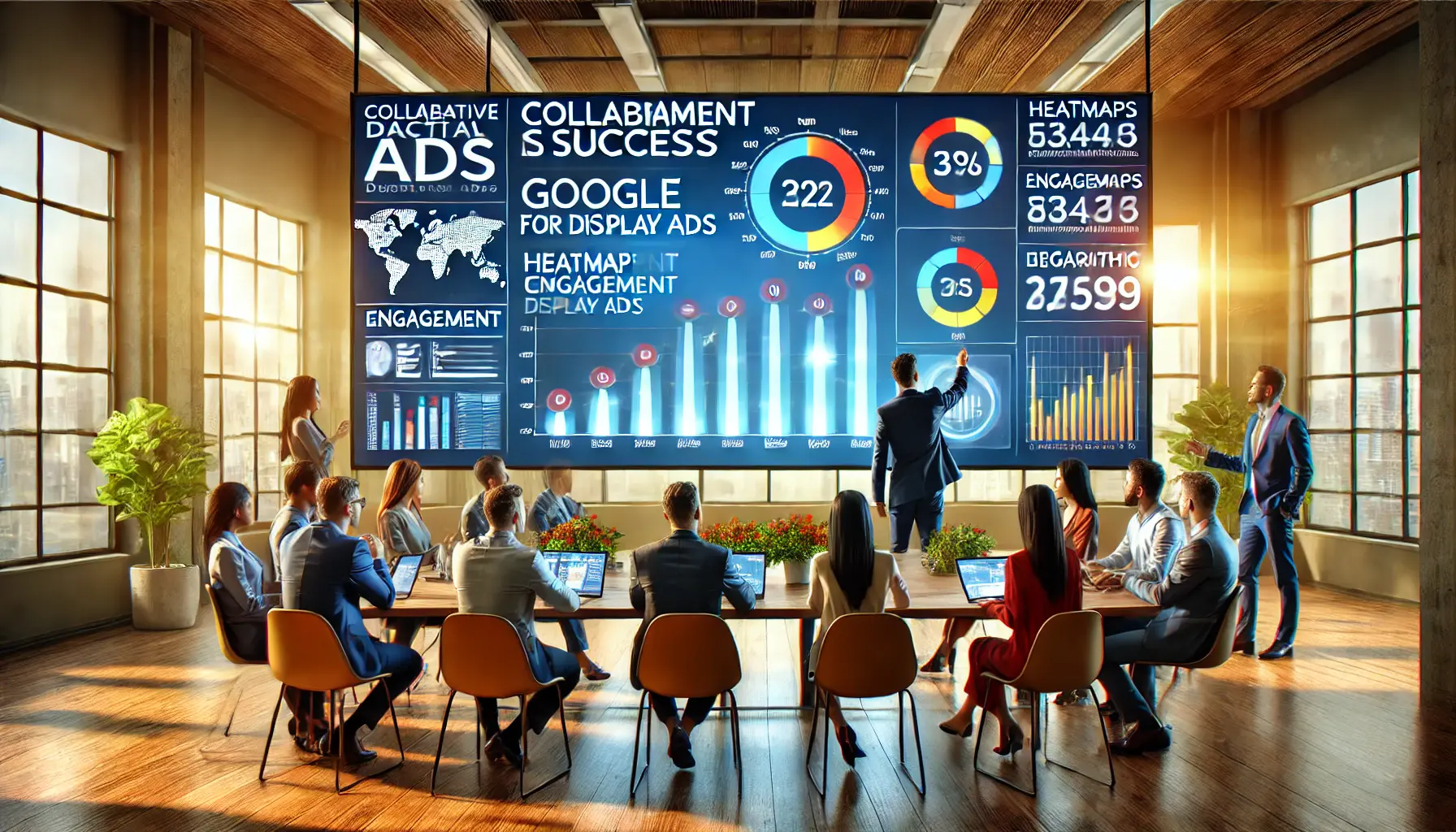
Tracking progress: Measuring success in collaborative Google Display Ads.
Measuring the Success of Collaborative Tactics in Google Display Ads
Using collaborative tactics in your Google Display Ads is a strategic move, but measuring their effectiveness requires precise evaluation.
By assessing key performance indicators (KPIs), you can determine the impact of your collaborative efforts and make informed decisions for future campaigns.

Precision analysis: Evaluating key metrics for collaborative campaign success.
Key Metrics to Assess Collaborative Campaign Performance
Monitoring specific metrics is essential to gauge the success of your collaborative display ad campaigns:
- Click-Through Rate (CTR): Measures the percentage of users who clicked on your ad after viewing it, indicating the ad’s relevance and appeal.
- Conversion Rate: Represents the percentage of ad clicks that result in a desired action, such as a purchase or sign-up, reflecting the campaign’s effectiveness in driving user engagement.
- Return on Ad Spend (ROAS): Calculates the revenue generated for every dollar spent on advertising, providing insight into the campaign’s financial efficiency.
- Cost Per Acquisition (CPA): Indicates the average cost to acquire a customer through the ad campaign, helping assess the cost-effectiveness of your strategies.
- Impressions: The total number of times your ad is displayed, offering insight into its reach and visibility.

Advanced insights: Leveraging Google Ads tools for performance analysis.
Utilizing Google Ads Tools for Performance Analysis
Google Ads offers robust tools to help you analyze your campaign performance:
- Google Ads Reports: Provide post-click performance metrics, offering insights into user behavior after interacting with your ads. These reports help you understand the user journey and conversion patterns.
- Conversion Tracking: Enables you to monitor actions users take after clicking on your ads, such as purchases or sign-ups, allowing for precise measurement of campaign effectiveness.
- Google Analytics Integration: By linking Google Ads with Google Analytics, you gain a comprehensive view of user interactions across platforms, enhancing your ability to assess campaign performance.
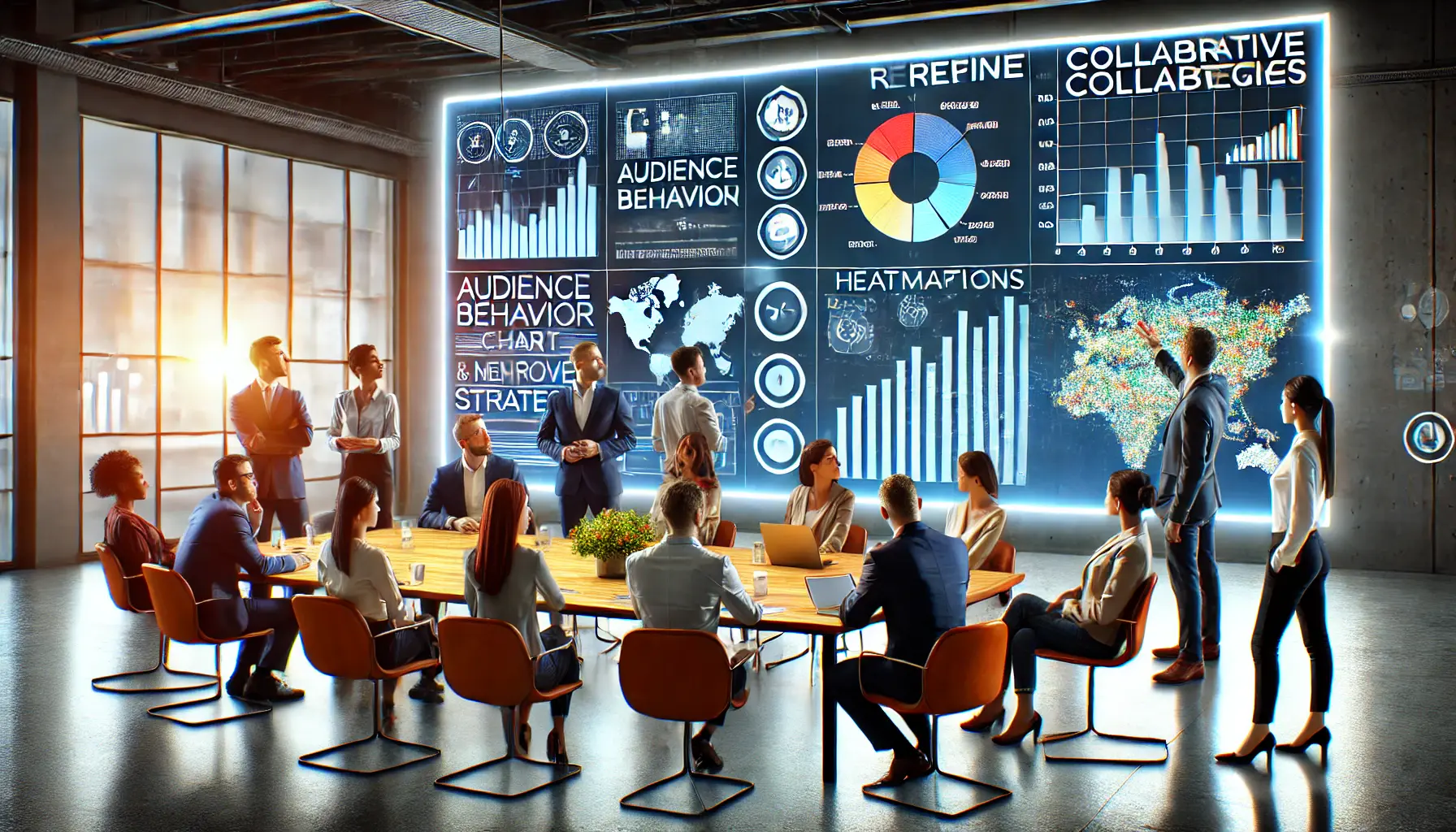
Refining success: Using data to improve collaborative strategies.
Interpreting Data to Refine Collaborative Strategies
Analyzing the collected data allows you to refine your collaborative advertising efforts:
- Identify Successful Partnerships: Determine which collaborations yield the highest engagement and conversions, focusing future efforts on similar partnerships.
- Optimize Ad Creatives: Assess which ad elements resonate with your audience, enabling you to enhance visuals and messaging for better performance.
- Adjust Targeting Parameters: Use performance data to fine-tune audience targeting, ensuring your ads reach the most responsive segments.

Proactive success: Continuously monitoring and adapting digital marketing strategies.
Continuous Monitoring and Adaptation
Success in collaborative Google Display Ads requires ongoing evaluation:
- Regular Performance Reviews: Continuously monitor your KPIs to track progress and identify areas needing improvement.
- Stay Updated with Industry Trends: Keep abreast of the latest developments in digital advertising to incorporate new strategies and maintain a competitive edge.
- Test and Iterate: Implement A/B testing to experiment with different approaches, using data-driven insights to guide adjustments and optimizations.
By diligently measuring and analyzing the performance of your collaborative tactics in Google Display Ads, you can enhance your advertising strategies, achieve your marketing objectives, and foster successful partnerships that drive business growth.
Tracking KPIs like CTRClick-Through Rate, the percentage of users who click on an ad after seeing it., ROASReturn on Ad Spend, a metric to measure revenue generated for every dollar spent on advertising., and CPACost Per Acquisition, the cost incurred to acquire a customer through an ad campaign. provides insights into the effectiveness of collaborative tactics, enabling data-driven refinements.
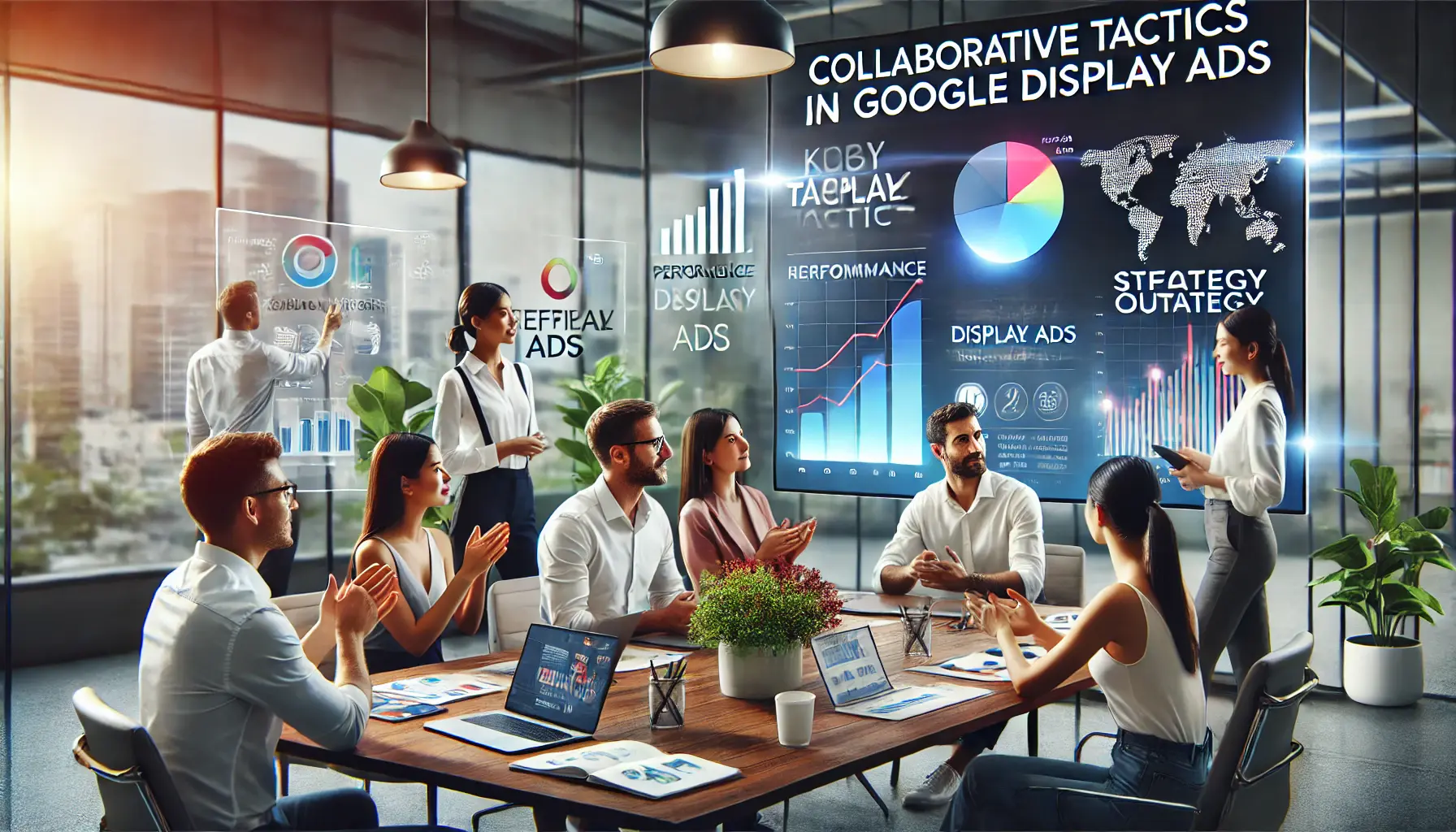
Collaborative success: Key takeaways for impactful Google Display Ads.
Key Takeaways on Collaborative Tactics in Google Display Ads
Collaborative tactics in Google Display Ads hold immense potential for businesses aiming to enhance their advertising strategies.
Through partnerships, pooling of resources, and creating unified campaigns, brands can achieve remarkable outcomes that they might not have been able to achieve independently.
These tactics enable businesses to connect with broader audiences, optimize their ad spend, and build long-lasting partnerships.

Power of teamwork: Collaboration for successful digital advertising campaigns.
The Importance of Collaboration in Digital Advertising
Collaboration fosters innovation and shared success in the competitive digital advertising landscape.
Whether through audience segmentation, co-branding strategies, or strategic partnerships, these tactics enable brands to tap into complementary strengths.
This synergy ensures campaigns are not only cost-effective but also impactful, reaching audiences with precision and relevance.

Achieving success: Maximizing results through strategic partnerships.
Maximizing Results Through Strategic Partnerships
Strategic partnerships are at the core of successful collaborative campaigns.
By aligning objectives, sharing resources, and developing integrated strategies, businesses can create ads that resonate with diverse audiences.
The ability to optimize ad spend through shared costs and expand reach through combined efforts underscores the value of these partnerships.

Continuous improvement: Measuring and refining collaborative efforts for success.
Measuring and Refining Collaborative Efforts
Measuring the success of collaborative tactics is essential for continuous improvement.
Key performance indicators such as click-through rates, conversion rates, and return on ad spend provide insights into campaign performance.
Tools like Google Ads Reports and Conversion Tracking empower businesses to analyze data effectively, refine strategies, and make data-driven decisions for future collaborations.

Sustaining success: Achieving growth through collaborative tactics.
Achieving Sustainable Growth with Collaborative Tactics
When implemented effectively, collaborative tactics in Google Display Ads pave the way for sustainable growth.
By maintaining visual consistency, leveraging co-branding, and continuously adapting to market trends, businesses can ensure their advertising efforts remain relevant and effective.
Moreover, the ability to measure success and adjust strategies accordingly ensures that collaborations remain mutually beneficial and aligned with business objectives.
Conclusion: Collaborative tactics are a game-changer for businesses looking to thrive in the competitive world of Google Display Ads.
By embracing these strategies, brands can unlock new opportunities, strengthen partnerships, and achieve their advertising goals with greater efficiency and impact.
Collaborative tactics enable businesses to optimize ad spend, build partnerships, and achieve impactful campaigns by leveraging shared resources and expertise.

Collaborative problem-solving: Addressing FAQs in Google Display Ads strategies.
Your campaigns can be managed by an agency specialized in Google Ads, check out our service page.
Google Display Ads: Collaborative Tactics – Frequently Asked Questions
Collaborative tactics can greatly enhance your advertising efforts on Google Display Ads.
Here are some frequently asked questions and their concise answers to assist you:
Collaborative tactics involve partnering with other brands or entities to create joint advertising campaigns, leveraging shared resources and audiences for enhanced reach and effectiveness.
Co-branding brings together the strengths and audiences of two brands, creating unified campaigns that increase engagement, expand reach, and build credibility with a broader audience.
Key metrics include click-through rates (CTR), conversion rates, return on ad spend (ROAS), and cost per acquisition (CPA) to assess the effectiveness of collaborative campaigns.
Strategic partnerships allow for shared advertising costs, access to new audiences, and combined resources, leading to more efficient use of ad budgets and improved campaign performance.
Tools like Google Ads Audience ManagerA tool within Google Ads for managing and analyzing audience segments. and Google Analytics help in creating and managing audience segments, enabling precise targeting for collaborative campaigns.
Establish brand guidelines, agree on design standards, and coordinate across all marketing channels to maintain a cohesive appearance in co-branded advertisements.
Audience segmentation allows tailored messaging, increased engagement, and higher conversion rates across targeted subsets of the collective audiences of partnering brands.
Search for brands offering complementary products or services, targeting similar audiences, and sharing similar marketing goals to create a mutually beneficial collaboration.
Challenges include aligning goals, maintaining consistent messaging, coordinating resources, and measuring shared success metrics between partnering brands.
